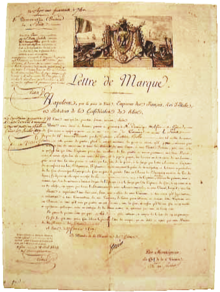
Back Kapersbrief Afrikaans تفويض رد اعتداء Arabic Patente de corsu AST Patent de cors Catalan Kaperei German Kaperisto Esperanto Patente de corso Spanish Lettre de marque French Patente de corso Galician Lettera di corsa Italian


A letter of marque and reprisal (French: lettre de marque; lettre de course) was a government license in the Age of Sail that authorized a private person, known as a privateer or corsair, to attack and capture vessels of a nation at war with the issuer. After capturing, the privateers could bring the case of that prize before their own admiralty court for condemnation and transfer of ownership to the privateer. A letter of marque and reprisal would include permission to cross an international border to conduct a reprisal (take some action against an attack or injury) and was authorized by an issuing jurisdiction to conduct reprisal operations outside its borders.
Popular among Europeans from the late Middle Ages up to the 19th century, cruising for enemy prizes with a letter of marque was considered an honorable calling that combined patriotism and profit. Such privateering contrasted with individuals conducting unlicensed attacks and captures of random ships, known as piracy, which was almost universally reviled.[1] In practice, the differences between privateers and pirates were often at best subtle and at worst a matter of interpretation.[2][3]
In addition to referring to the license, the terms "letter of marque" and "privateer" were sometimes used to describe the vessels used to pursue and capture prizes. In this context, a letter of marque was a lumbering, square-rigged cargo carrier that might pick up a prize if the opportunity arose in its normal course of duties. In contrast, the term privateer generally referred to a fast and weatherly fore-and-aft rigged vessel, well armed and carrying more crew, intended exclusively for fighting.[4]
Letters of marque allowed governments to fight their wars using private captains and sailors, akin to mercenary soldiers, to hunt down enemies and fight their wars instead of using their navies. Oftentimes it was cheaper and easier for governments to issue letters of marque to privateers than to maintain a longstanding navy. Instead of building, funding, and maintaining a navy in times of peace and in times of war, governments would issue letters of marque to privateers so they could fight the nation's battles. This way, the government issuing the letter of marque were not responsible to fix or maintain any of the privateers' ships since they were owned by the privateers.[5]
- ^ Upton's Maritime Warfare and Prize pp 170–171; 176. Discusses the history of letters of marque and reprisal. Upton is considered the foremost 19th-century American scholar on prize law.[according to whom?]
- ^ Hewitson, Skull and Satire, p. 19–20.
- ^ Konstam, Pirates: Predators of the Seas, p. 10.
- ^ Donald Petrie, The Prize Game p. 4: Noting cumberous square-rigged cargo carriers that often secured letters of marque "just in case", "[c]onfusingly, such vessels were themselves called 'letters of marque'." Geoffrey Footner, Tidewater Triumph, pp ?: Discusses the difference between letter of marque vessels and privateers.
- ^ "The Rise, Fall, and Rise Again of Privateers | Alexander T. Tabarrok". The Independent Institute. Retrieved March 24, 2021.
© MMXXIII Rich X Search. We shall prevail. All rights reserved. Rich X Search